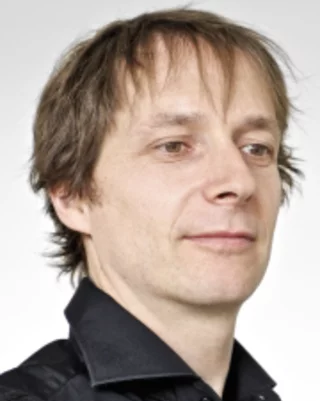Biography
Bill Pedrini is staff scientist within the Photon Science division. He studied theoretical physics at ETH Zürich, and obtained his PhD degree in 2002 with a thesis addressing topological field theories. He then moved to experimental physics, applying nuclear magnetic resonance methods for investigations in condensed matter at ETH Zürich, as well as for the structure determination of proteins in solution both at ETH Zürich and the Scripps Research Institute in La Jolla (CA, USA). In 2010 he joined the Paul Scherrer Institute and was involved in the SwissFEL project since its early planning phase. After start of SwissFEL operation, he worked as a beamline scientist at the Bernina experimental station. In 2019 he moved to the Quantum Technology group, with responsibilities in the activities involving X-ray experimental techniques.
Institutional responsibilities
The main responsibility is the lead of the Cristallina project, aiming to the realization of a third experimental station on the SwissFEL hard X-ray beamline ARAMIS, dedicated to the study of quantum matter in extreme conditions and to protein crystallography.
Scientific research
The research interest are in various X-ray experimental methods and phenomena, ranging from coherent methods to dynamical diffraction. The current focus is on the study of condensed matter close to a quantum critical point by X-ray diffraction and coherent X-ray scattering.
Selected publications
For an extensive overview we kindly refer you to our publication repository DORA.
X-ray fluorescence detection for serial macromolecular crystallography using a JUNGFRAU pixel detector, I. Martiel, A. Mozzanica, N. L. Opara, E. Panepucci, F. Leonarski, S. Redford, I. Mohacsi, V. Guzenko, D. Ozerov, C. Padeste, B. Schmitt, B. Pedrini and M. Wang, Journal of Synchrotron Radiation volume 27, pages 329-339 (2020).
Detection of heavy elements, such as metals, in macromolecular crystallography (MX) samples by X-ray fluorescence is a function traditionally covered at synchrotron MX beamlines by silicon drift detectors, which cannot be used at X-ray free-electron lasers because of the very short duration of the X-ray pulses. Here it is shown that the hybrid pixel charge-integrating detector JUNGFRAU can fulfill this function when operating in a low-flux regime. The feasibility of precise position determination of micrometre-sized metal marks is also demonstrated, to be used as fiducials for offline prelocation in serial crystallography experiments, based on the specific fluorescence signal measured with JUNGFRAU, both at the synchrotron and at SwissFEL. Finally, the measurement of elemental absorption edges at a synchrotron beamline using JUNGFRAU is also demonstrated.
C. Casadei, K. Nass, A. Barty, M. S. Hunter, C. Padeste, C.-J. Tsai, S. Boutet, M. Messerschmidt, L. Sala, G. J. Williams, D. Ozerov, M. Coleman, X.-D. Li, M. Frank and B. Pedrini, Structure-factor amplitude reconstruction from serial femtosecond crystallography of two-dimensional membrane-protein crystals, International Union of Crystallography Journal volume 6, pages 34-45 (2019).
Serial femtosecond crystallography of two-dimensional membrane-protein crystals at X-ray free-electron lasers has the potential to address the dynamics of functionally relevant large-scale motions, which can be sterically hindered in three-dimensional crystals and suppressed in cryocooled samples. In previous work, diffraction data limited to a two-dimensional reciprocal-space slice were evaluated and it was demonstrated that the low intensity of the diffraction signal can be overcome by collecting highly redundant data, thus enhancing the achievable resolution. Here, the application of a newly developed method to analyze diffraction data covering three reciprocal-space dimensions, extracting the reciprocal-space map of the structure-factor amplitudes, is presented. Despite the low resolution and completeness of the data set, it is shown by molecular replacement that the reconstructed amplitudes carry meaningful structural information. Therefore, it appears that these intrinsic limitations in resolution and completeness from two-dimensional crystal diffraction may be overcome by collecting highly redundant data along the three reciprocal-space axes, thus allowing the measurement of large-scale dynamics in pump-probe experiments.
A. Fernandez-Rodriguez, V. Esposito, D. F. Sanchez, K. D. Finkelstein, P. Juranic, U. Staub, D. Grolimund, S. Reiche and B. Pedrini, Spatial displacement of forward-diffracted X-ray beams by perfect crystals, Acta Crystallographica Section A: Foundations and Advances volume 74, pages 75-87 (2018).
Time-delayed, narrow-band echoes generated by forward Bragg diffraction of an X-ray pulse by a perfect thin crystal are exploited for self-seeding at hard X-ray free-electron lasers. Theoretical predictions indicate that the retardation is strictly correlated to a transverse displacement of the echo pulses. This article reports the first experimental observation of the displaced echoes. The displacements are in good agreement with simulations relying on the dynamical diffraction theory. The echo signals are characteristic for a given Bragg reflection, the structure factor and the probed interplane distance. The reported results pave the way to exploiting the signals as an online diagnostic tool for hard X-ray free-electron laser seeding and for dynamical diffraction investigations of strain at the femtosecond timescale.The first experimental observation of transverse spatial echoes generated by forward Bragg diffraction of an X-ray beam propagating through a perfect thin crystal is reported.
P. Villanueva-Perez, B. Pedrini, R. Mokso, P. Vagovic, V. A. Guzenko, S. J. Leake, P. R. Willmott, P. Oberta, C. David, H. N. Chapman and M. Stampanoni, Hard x-ray multi-projection imaging for single-shot approaches, Optica volume 5, pages 1521-1524 (2018).
High-brilliance x-ray sources (x-ray free-electron lasers or diffraction-limited storage rings) allow the visualization of ultrafast processes in a 2D manner using single exposures. Current 3D approaches scan the sample using multiple exposures, and hence they are not compatible with single-shot acquisitions. Here we propose and verify experimentally an x-ray multi-projection imaging approach, which uses a crystal to simultaneously acquire nine angularly resolved projections with a single x-ray exposure. When implemented at high-brilliance sources, this approach can provide volumetric information of natural processes and non-reproducible samples in the micrometer to nanometer resolution range, and resolve timescales from microseconds down to femto-seconds.
B. Pedrini, A. Menzel, V. A. Guzenko, C. David, R. Abela and C. Gutt, Model-independent particle species disentanglement by X-ray cross-correlation scattering, Scientific Reports volume 7, article number: 45618 (2017).
Mixtures of different particle species are often investigated using the angular averages of the scattered X-ray intensity. The number of species is deduced by singular value decomposition methods. The full disentanglement of the data into per-species contributions requires additional knowledge about the system under investigation. We propose to exploit higher-order angular X-ray intensity correlations with a new computational protocol, which we apply to synchrotron data from two-species mixtures of two-dimensional static test nanoparticles. Without any other information besides the correlations, we demonstrate the assessment of particle species concentrations in the measured data sets, as well as the full ab initio reconstruction of both particle structures. The concept extends straightforwardly to more species and to the three-dimensional case, whereby the practical application will require the measurements to be performed at an X-ray free electron laser.


